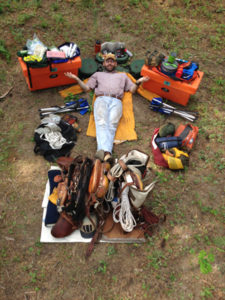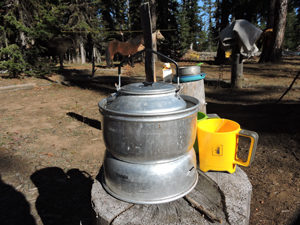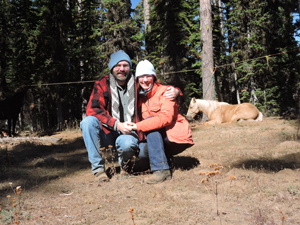6 Steps to a Successful Pack Trip
by Robert Eversole

For many of us the ultimate in equine vacations is to venture into the backcountry with our horse. Day rides and horse camping at an established campground is good. Camping with horses in the depths of the backcountry is grand.
But how do you plan a trip into an area where the clatter of civilization is drowned by the serenity and solitude of wilderness? Loading a packhorse with necessities and leaving the trailer far behind ups the ante from a standard day ride. With planning and preparation, you’ll be set for some of the most memorable outdoor experiences of your life.
The following six steps outline what’s necessary for a successful first backcountry trip.
Step 1: Where Do I Go?
Pick an area that is inspiring, matches your skill set, and fits within your time and budget constraints. For example, if you like mountain riding and are looking for a three-day trip on well-marked trails, the Bob Marshall Wilderness might be ideal. For choosing a destination and helping select a trail route, www.trailmeister.com, regional equine clubs, and the land manager’s recreational rangers are excellent resources.
Time of Year – Consider the best time of year to visit the spot you’ve chosen. Mid-summer is perfect for the Cascades and Rockies, while fall is perfect for areas on the East Coast. Climate, elevation, and terrain will factor into what types of shelter you’ll need for yourself, and if you’ll be able to find water and grazing for your animals.
Trail Type and Distance – What type of route are you planning? A loop with a new view each day? Out and back to a scenic lake? A point-to-point trek that might require someone to shuttle your truck and trailer? As you determine how many miles you’ll be riding each day, consider the terrain you’ll be passing through and whether you prefer a leisurely pace or want to cover ground. A good rule of thumb is that horses in the backcountry will travel at about 3 miles an hour.
Maps and Regulations – Research popular trail areas online at www.trailmeister.com. Acquire trail maps and guidebooks for the area that you’ve chosen. Learn the rules and regulations for the area with the land manager before you go. Are campfires allowed? Is weed-free feed required? Is grazing allowed? Where can you expect to find water? Are permits required? Be sure that your horses are up to date on vaccinations and that you have the necessities for crossing states lines—Coggins test, health certificate, and brand inspections.
Step 2: What Should I Bring?
What you carry will be determined by your destination and the type of weather you’ll likely encounter. The tack and camping gear you take should be as practical, comfortable, and as lightweight as possible. Your pack animal will thank you!
Organize gear into the following kits for most pack trips:
Human Needs
- Clothing – Rain pants and jacket, stocking cap and gloves, camp shoes, insulating layers, etc.
- Shelter – tent/hammock, foam insulation pad, sleeping bag, etc.
- Cooking – lightweight backpacking stove and fuel, pots, cooking utensils, cup, bowl, spork, sponge and soap, water filter, etc.
- Emergency/Essentials – First Aid kit, PLB (personal locator beacon), headlamp, lighter/matches, map and compass, duct tape, repair kit, knife, toiletries, camera/journal, etc. Remember to keep the essentials on you in case you separate from your riding animal.
Equine Needs
- Riding Saddle – Make sure it fits well and that you have a good saddle pad.
- Pack Saddle – The two main types of pack saddles are the Sawbuck and the Decker. Each type has its own strengths and weaknesses. More important than which type of pack saddle is that you have the knowledge to use it. An excellent tutorial manual is The Packers Guidebook by Ed Haefliger (http://www.mtcanaryco.com).
- Panniers – You’ll need some type of bag, box, or container to hold your camp. Options include hard boxes that can deter a hungry bear or soft bags that are more flexible on your pack animals. Regardless of the type, balance is everything, so be sure to load them with the same weight on each side. Panniers are easy to use and work well.
- Saddle Bags –Use them sparingly and only for lightweight items. It is entirely too easy to place too much weight behind the saddle and over your riding animal’s kidneys. Also, be careful saddle bags don’t interfere with mounting and dismounting.
- Horn Bags – Indispensable for holding the camera for calendar-worthy trip photos!
- Horse Containment Options – There are several good options for keeping your animals in one place during your trip. I use the three below. Before using any of these techniques in the backcountry make sure to get your horses used to them at home first.
- Highline – A strong rope strung between two sturdy trees protected by tree savers will ensure that you’ll be riding instead of walking the following morning.
- Hobbles – These will nearly immobilize your horse… at first. Where grazing is permitted, hobbles are an excellent way to allow your animals to graze while under your strict supervision.
- Electric Fencing – An excellent way to allow your animals to graze and relax while under your supervision. Electric fencing is not a substitute for a highline. Your animals may believe in the bite of the fence, but the local elk, moose, and deer don’t and they are apt to bolt and tear down the thin line.
- First Aid Kit – Check with your veterinarian for suggestions about what to take and how to treat minor bumps.
- Miscellaneous– Brush, curry, hoof pick, insect repellent, collapsible bucket, etc.
Trim the Fat – As you gather your gear, consider the weight and volume. Think about what you can do without, which items can do double duty, and pare everything down to the essentials. Your animals will be doing the hard work. Do them a favor and only take what you need, not everything you want. Regardless of the trip and your wants, a well-stocked First Aid kit that can serve both you and your mounts is a necessity, as well as the knowledge on how to address emergencies.
Step 3: What’s to Drink?
It’s not practical to haul water. You’ll need to plan your trip around reliable sources of water for the area and season. Call before you haul. Talk to the land manager to get data on lakes, streams, and other water for your horses.
Water is more complicated for humans. Where equines are tolerant of water in the wild, we puny humans are at risk from any number of waterborne parasites. They come with many names, but most people simply call it Giardia or “Hell on Earth”. Thankfully, prevention is straightforward. Treat your water before you use it, cook with it, or drink it. Treatment can be as simple as boiling, adding purification tablets or filtering.

Step 4: What’s for Dinner?
Meal planning is about packing enough calories to fuel your days without asking your animals to tote a ton of extra weight. Whether you decide to purchase pre-made meals or create your own, be sure to create a meal plan for each day.
Trying to pack all the feed that horses and mules eat daily is cumbersome and impractical. Instead plan your trip around good grazing areas. Most good grazing will have a water source nearby as well. Contact the land manager for information on where and when to expect to find grass and water.
Organize –Place ingredients for each meal in a zip-top or vacuum bag. Label them Breakfast Day 1, Dinner Day 2, etc. This will help keep everything organized and avoid a campsite yard sale.
Protect– Whether it’s a chipmunk or grizzly bear (the former is more likely than the latter) you’ll want to protect your food from the natives. Bear resistant pannier boxes are available and even required in many areas. Hanging food is another option to keep the local inhabitants out of your backcountry cuisine.
Extras – There’s nothing better than a good meal at the end of a long day on the trail. Elevate the standard camp meal to a new dimension by including a few extras like a block of cheese, some fresh veggies, or a chocolate bar!
Step 5: What if Something Bad Happens?
Stick to the Plan – Make sure that someone reliable has your trip itinerary. It should include which trailhead you’re departing from, where you’re camping, when you’ll return, and any critical medical issues. This information helps guide local authorities if you don’t return on time.
Carry a PLB – In remotes areas beyond the reach of cell coverage a PLB can send a distress signal to alert local authorities and search and rescue teams if you have a real emergency.
Take the Skills and Gear You Need – All the gear in the world won’t help if you don’t know how to use it. Take a first aid course, for humans and one for horses. Learn to use a map and compass. With some basic knowledge, you’ll be able to handle most minor mishaps.
Step 6: How do I Prepare?
Take a Test Drive – Take a short overnight trip before embarking on a longer trek. Even better, camp out in your backyard where mistakes and missing gear is easily remedied. Your first time hobbling and setting up a highline will be much safer if you repeatedly practice at home. Become familiar with your equipment and make sure that it works well before you leave home; it can save you major troubles down the trail.
Get Fit – You and your horse need to be physically fit for backcountry trips. Start an exercise program for both of you at least six weeks before your trip. Aim for at least 3-4 workouts and rides each week. Your vet and your personal physician can help you determine the optimum training regimes to get your mount and you in the peak of shape.
You can have backcountry adventures by investing time in planning, preparing, and practicing at home. This opens the gate to endless travels and a lifetime of epic trips and memories. For more information on this and other trail riding and horse camping topics visit www.trailmeister.com the world’s largest guide to equine trails and horse camps.
Originally Published May 2017 Issue

Robert Eversole, ”the trail meister,” owns www.TrailMeister.com, the largest database of horse riding and camping areas in the U.S. with free trail and trailhead information, trail maps, and much more to help horse enthusiasts experience the joys of trail riding. Robert is a registered riding instructor with PATH International, a mounted search and rescue team member, and a U.S. Marine who has served on the board of the Backcountry Horsemen of Washington (BCHW). He is enjoying his new career helping fellow trail riders stay found and safe on the trail. When not on the trail, The Trail Meister resides near Spokane, WA and teaches land navigation to a wide variety of outdoor groups across the nation. For North America’s largest horse trail and camping directory, trail tips, and more, visit www.TrailMeister.com.






